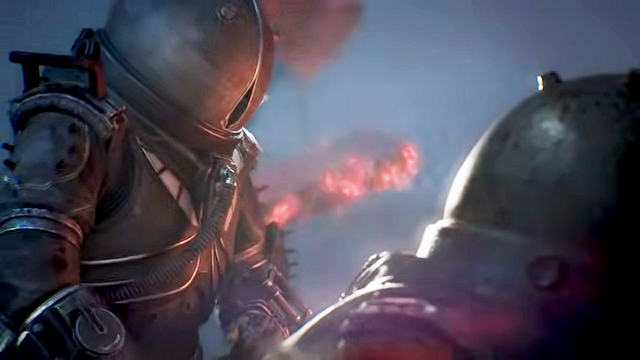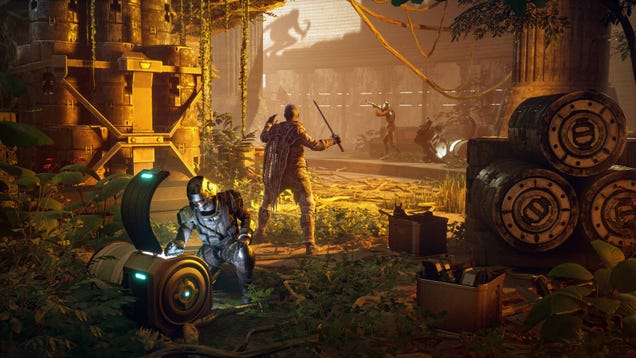
It has been 16 years since STALKER: Shadow of Chernobyl. That means it’s also been 16 years since I last played a STALKER game. I admired the original but never loved its wonky, ambitious heart enough to explore its two follow-ups. But despite that decade-plus time away from the series, when I sat down to play STALKER 2: Heart of Chornobyl at gamescom 2023 it felt like I’d never been away. As if reactivating a long-dormant muscle, I found its creeping pace and scrappy gunfights instantly familiar. That’s good news for devout fans of the cult PC series, but perhaps more of a challenge for the potential legion of newcomers that will arrive at launch via Game Pass.
Despite its Unreal Engine 5 base and prominent Microsoft support, the fifteen-minute gamescom demo suggests that STALKER 2 still sits in the ‘eurojank’ category; the colloquial term for eastern European games that are overly ambitious and technically wobbly. This sequel’s animations are stiff, its human faces look like haunted waxworks, the AI struggles to stay smart, and inventory management is fiddly. But in exchange for that you get a Soviet bloc world that feels authentic and layered with opportunity. This demo may have been short, but its small areas featured numerous angles for stealth or action approaches, fun flanking routes, and a variety of side objectives.
My sample misadventure through the rusted carcass that is the Chornobyl Exclusion Zone begins with a rabid dog mauling away at my ankles. The mutt is dispatched by kicking it into an anomaly; the rippling miniature storms that litter STALKER’s world. The dog explodes into a dozen gory chunks, demonstrating that these anomalies are to be steered well clear of. I’m also given some bolts, which can be thrown into anomalies from a safe distance to cause them to erupt and open up a safe path. These storms don’t turn up again for the rest of the demo, but I hope in the full game they fulfil a dual role as environmental hazard puzzles and traps to lure enemies into.
Further down the road I discover a man fighting off more of those mutated dogs. My over-cautious nature sees me blast a hole in the side of his head (why would I trust anyone in this god-forsaken place?), which results in a notification that I’ve failed an optional objective. Thankfully I’m able to reload the demo and approach in a more friendly manner, but this slip-up shows off STALKER 2’s push for realism; NPCs are not safe from stray or purposeful shots, and objectives will change with their fates.
With the dogs dispatched on this fresh attempt, I have a quick chat with the survivor and his injured friend. The conversation really highlights STALKER 2’s graphical limitations; these characters look like Bethesda NPCs from the previous generation and move with a similar lack of grace. Beyond this room, the wider world feels a lot like a cutting-edge PC game from ten years ago; still detailed and sharp in a grungy way that suits the decayed setting, but clearly not of the modern era. Graphics are obviously not a vital part of the experience, but considering its next-gen exclusivity and Unreal Engine 5 foundations, I did expect STALKER 2 to be more of a looker.
These are tense, dirty firefights with plenty of character and just a dash of fear.
The survivors, named Zhorik and Gloomy, turn out to be fellow STALKERs who have been attacked by bandits. Zhorik laments that their attackers have seized the nearby boiler house. I volunteer to take on the bandits, knowing it will be the ideal testing ground for the combat systems. It turns out to be a pretty classic outpost-style location; a building and courtyard arrangement surrounded by a perimeter wall. A gateway provides a direct route in, but crumbling brickwork to the side signals an alternate route in for a stealthier approach. I duck through the hole and behind a large fuel drum, peering beneath it to spy on the patrolling bandits. And then, one slightly fumbled headshot later, I’m thrust into a skirmish that feels completely true to the origins of the series.
STALKER 2’s guns are snappy and punchy in the way you’d expect of firearms that have survived being lugged around a rusting world. But, in an approach that puts them a world apart from weapons in modern shooters, they feel almost entirely unreliable. In Call of Duty, if you shoot an enemy in the head, that enemy is dead, and you even get a visual and audio cue to confirm that. STALKER 2, in keeping with both its predecessor and real life, offers no such feedback. Bullet spread is difficult to predict, and that gets trickier at longer ranges. It makes for tense, dirty firefights with plenty of character and just a dash of fear. There are very few games like this on the modern FPS scene, especially on consoles, and I admire that developer GSC Game World is doubling down on its unique flavour.
But, as with everything in this demo, the good comes with the jank. The bandits are not exactly the sharpest tools in the zone, and spend their time either bumbling in the open or glued to cover. I hope that in the months between now and launch, GSC can sharpen the AI’s senses. This is not to say that they are incapable of being a danger in their current state; I’m unceremoniously gunned down on my first attempt at clearing the camp. This does highlight STALKER 2’s approach to death, though, which resurrects me a few metres outside the boiler house and keeps the world state intact. I’d much rather death send me back to a previous save and allow me a fresh attempt at a challenge.
With the bandits cleaned up, a voice on my radio informs me of an incoming ‘emission’, and advises that I take cover. I sprint through the woods in search of a building and eventually find my way into a shabby cabin just as my Geiger counter goes into overdrive. Through a gap in the roof I watch as the sky turns a vibrant red, pierced occasionally by searing forks of white lightning. My subsequent death amid the unending rattle of radiation warnings signals the end of my short demo, but this concluding moment hints at emissions being regular occurrences that will force you to drop whatever you’re doing and run for your life. I hope the AI is as responsive to these situations as you need to be, because the idea of battles breaking out as characters fight for access to radiation-safe buildings is a thrilling one.
And that’s all I saw. This was an incredibly short and simple demo for what is presumably – based on its predecessors, at least – going to be a fairly complex FPS. I’m left wondering what the bigger picture is, how the systems interlink and overlap, and how flexible its combat encounters are. But what I did learn from this slim sample is that STALKER 2 feels somewhat of a remake of the original game. Not physically – everything here is new. But spiritually and mechanically, this slice felt almost exactly like my memories of the 2007 original.
Heart of Chornobyl’s old-school approach is great news for the original game’s dedicated fanbase, but I’m not sure what it means for more mainstream players who are being coaxed into its orbit by Microsoft’s big Game Pass push. They are likely better served by Metro: Exodus, the other Soviet bloc shooter that – despite being four years old – feels more modern than anything in this demo. But for those with a tolerance for rough edges and a hunger for something that’s unlike anything in the contemporary console space, STALKER 2 could be something to keep an eye on. We’ll need a much more substantial demo to truly know if it’s worth being excited about, though.
Matt Purslow is IGN’s UK News and Features Editor.





